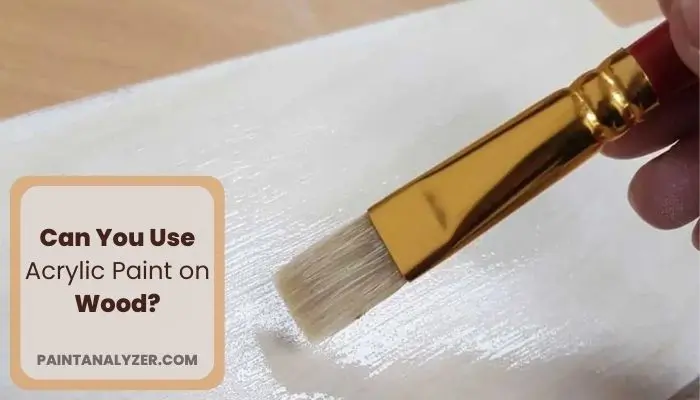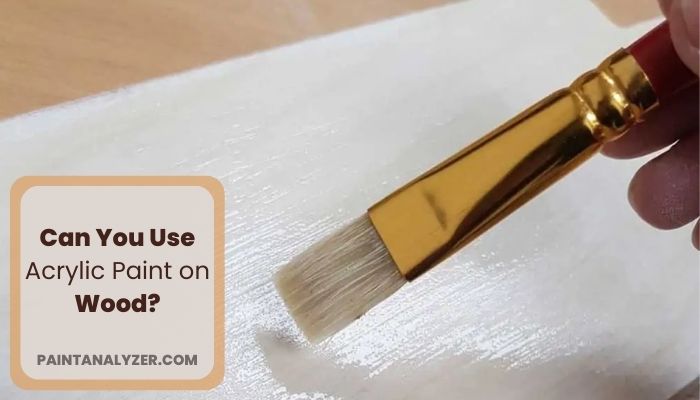Acrylic paint is a versatile medium that can be used on a variety of surfaces, including wood. While there are some considerations to keep in mind when painting with acrylics on wood, such as the type of wood and the desired finish. Are you wondering if you can use acrylic paint on wood?
The short answer is yes! It is possible to use acrylic paint on wood. However, it is important to note that the wood must be properly prepared first in order to ensure that the paint adheres properly. The surface of the wood should be sanded smooth and then primed with a good-quality wood primer.
Overall, the process is relatively simple. With a few supplies and a bit of time, you can transform a wood surface into a work of art.

Is it possible to use acrylic paint on wood?
Acrylic paint can be used on wood, but it is important to understand how the paint will interact with the surface before beginning. Acrylic paint is a plastic-based paint, so it will not adhere to the wood in the same way as other types of wood paint. The paint will sit on top of the wood, rather than sinking in and bonding with the material. This can create a few challenges when working with acrylic paint on wood.
Acrylic paint is a water-based paint, so it is possible to use it on wood. However, it is important to make sure the wood is properly sealed before painting, as acrylic paint can be absorbed into the wood and cause the paint to peel.
The paint can be more likely to chip and flake off of the surface. Paint can be more difficult to blend and create smooth transitions of color. The paint can dry more quickly than usual, so it is important to work in small sections and have a plan for how to blend the colors before beginning to paint.
Despite these challenges, acrylic paint can be a great option for painting on wood. The paint is easy to work with and can be very forgiving. With a little practice, it is possible to create beautiful works of art using acrylic paint on wood.
How Do You Paint Wood using Acrylic Paint?
Acrylic paint can be used on a variety of surfaces, including wood. When painting wood with acrylics, there are a few things to keep in mind in order to get the best results.
Prepping wood for acrylic paint is a multi-step process that involves sanding, priming, and painting. Sanding the wood will help to create a smooth surface for the paint to adhere to. Priming the wood will help to protect it from moisture and ensure that the paint adheres properly.
Clean the Surface
Start by cleaning the surface. Make sure that the surface you’re painting is clean and free of any dirt or debris.
Sand the Surface
It is important to sand the surface of the wood before painting. This will help to create a smooth surface for the paint to adhere to. Once the surface is sanded, be sure to wipe away any dust with a damp cloth.
Select Color
Choose the paint color you would like to use. You can either use a single color or mix different colors together to create a unique look. Once you have decided on your color, it is time to start painting!
Start Painting
To paint with acrylics, start by applying a thin layer of paint to the wood. Once the first layer is dry, apply a second layer of paint. For best results, allow the paint to dry completely between each layer.
Let the paint dry completely
Once you have achieved the desired look, allow the paint to dry completely before sealing the wood with a clear sealer. This will help to protect the paint and keep it from chipping or fading over time.

Can you use Acrylic Paint on Wood Without Primer?
If you’re looking to paint your wood surfaces without having to use a primer, then acrylic paint is the way to go. This type of paint is specifically designed to adhere to surfaces without the need for a separate binding agent, which makes it perfect for use on wood. Plus, acrylic paint dries quickly and is very durable, so it’s ideal for high-traffic areas or furniture that gets a lot of wear and tear.
However, depending on the type of wood and the desired finish, you may need to use a primer. But unfinished wood is the best surface for painting with acrylics, as it will absorb the paint and provide a stronger bond. If you’re painting over finished wood, sanding the surface first will help the paint to adhere.
When painting with acrylics on wood, you can achieve different effects depending on the type of paint you use. Opaque paint will give you solid, even coverage, while transparent paint will allow the wood grain to show through.
If you want a high-gloss finish, use glossy acrylic paint. For a matte finish, use flat or matte paint.
Before painting, test the paint on a small area of the wood to see how it will look and how it will adhere. Once you’re happy with the results, you can proceed with painting the entire surface.
Prepare Wood for painting with Acrylic paint
Is Water-Based Acrylic Paint good for Wood?
Water-based acrylic paint is a great option for painting wood. It is durable and long-lasting, and it won’t chip or peel as some other paints can. Plus, it’s easy to clean up with just soap and water. Acrylic paint is easy to apply and dries quickly, making it a great choice for both novice and experienced painters. You won’t have to wait long to see the finished product.
When painting with water-based acrylic paint on wood, it is important to prepare the surface properly before painting. Sand the wood to create a smooth surface for the paint to adhere to. Additionally, make sure to clean the wood thoroughly to remove any dust or debris left from sanding, as this can affect the paint’s adhesion. Once the surface is smooth and clean, you can start applying the acrylic paint in thin layers for the best results. If you’re unsure about the process, you might want to look up how to sand acrylic paint to ensure you achieve the perfect finish.
Once the wood is sanded, you can apply a primer before painting to help the paint adhere better and create a more durable finish. For a high-gloss finish, consider using water-based acrylic paint.
Can Acrylic Paint Remove from Wood?
Acrylic paint is permanent on wood when it is used as exterior paint. It will last for years without fading or chipping. However, if you use it indoors, it will only last for a few years before it starts to fade and chip. So, sometimes you may want to remove it from the wood surface. Whether you’re trying to remove dried-on paint or wet paint, there are a few methods you can try.
Paint Stripper
One way to remove acrylic paint from wood is to use a paint stripper. Paint strippers are chemicals that are designed to break down paint so that it can be easily removed. They work by breaking down the paint’s binder, which is the part of the paint that helps it adhere to the surface. Paint strippers can be very effective at removing paint, but they can also be very harsh. Be sure to follow the instructions on the stripper and wear gloves and a respirator to protect yourself.
Sand the Paint
If you don’t want to use a paint stripper, you can try sanding the paint off. This will work best if the paint is already dry. Start with coarse grit sandpaper and then move to a finer grit to remove any remaining paint. You may need to use a power sander to remove all of the paint.
Heat up the Paint
Another option is to use heat to remove the paint. This can be done with a heat gun or a hair dryer. Hold the heat gun or hair dryer about six inches away from the paint and move it back and forth until the paint starts to blister. Once the paint is blistered, you can scrape it off with a putty knife.
Chemical Solvent
You can also try using a solvent to remove the paint. Acetone is a common solvent that can be used to remove paint. Apply the acetone to a rag and then rub it onto the paint. The acetone will dissolve the paint and you can wipe it away.
Is Bamboo Considered a Type of Wood When Painting with Acrylic?
When painting with acrylic, it’s essential to know whether bamboo is considered a type of wood. Although bamboo is often categorized as wood, technically, it is a type of grass. However, for the purpose of using acrylic paint for bamboo, treating it like wood is the recommended approach.
Conclusion
Acrylic paint is water-based, which means it will not damage the wood. Painting wood not only adds a new layer of color and interest to a room, but it also helps to protect the wood from damage or loss if the paint fades, or becomes damaged.
Unlike paint made with solvents, acrylic paint won’t crack, peel or blister. It’s often less expensive and dries more quickly than oil paint. Wood is porous, though. If it’s untreated, wood will absorb water-based paint, making it appear duller.
Acrylic paint won’t perform as well on untreated wood. Instead, test your piece in an inconspicuous area before painting the entire surface.
